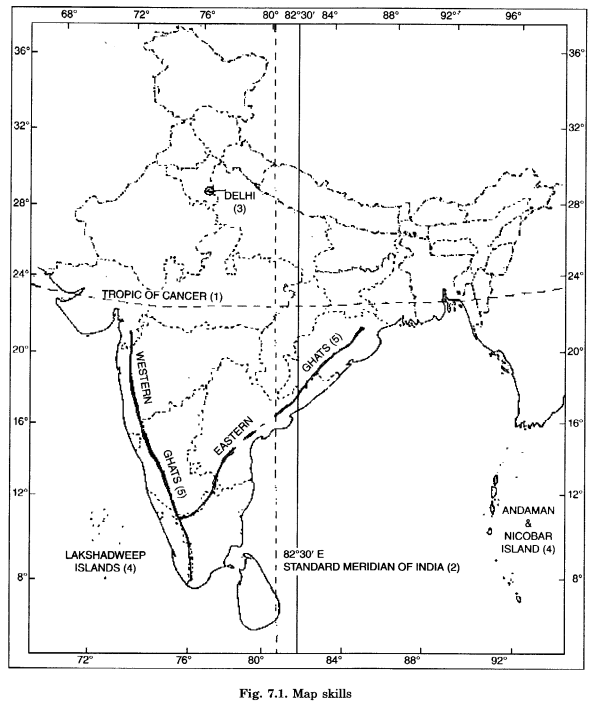NCERT Solutions for Class 6 Social Science Geography Chapter 8 India: Climate Vegetation and Wildlife are part of NCERT Solutions for Class 6 Social Science. Here we have given NCERT Solutions for Class 6 Social Science Geography Chapter 8 India: Climate Vegetation and Wildlife.
| Board | CBSE |
| Textbook | NCERT |
| Class | Class 6 |
| Subject | Social Science Geography |
| Chapter | Chapter 8 |
| Chapter Name | India: Climate Vegetation and Wildlife |
| Number of Questions Solved | 3 |
| Category | NCERT Solutions |
NCERT Solutions for Class 6 Social Science Geography Chapter 8 India: Climate Vegetation and Wildlife
NCERT TEXTBOOK EXERCISES (Pages 64-66)
Question 1.
Answer the following questions briefly.
(a) Which winds bring rainfall in India? Why is it so important?
(b) Name the different seasons in India.
(c) What is natural vegetation?
(d) Name the different types of vegetation found in India.
(e) What is the difference between evergreen forest and deciduous forest.
(f) Why is tropical rainforest also called evergreen forest?
Answer:
(a) Monsoon winds bring rainfall to India. These winds are very important because rainfall is necessary for crops and agricultural activities in India.
(b) Different Seasons:
- Cold weather (winter) season
- Hot weather (summer) season

- South-west monsoon (rainy) season
- Season of retreating monsoon
(c) The plant community v/hich has been left undisturbed over a long period of time. They grow on their own, without interference from human beings. They adjust to climatic and soil conditions.
(d) The different types of vegetation found in India are:
- Tropical evergreen forest
- Tropical deciduous forest
- Thorny bushes
- Mountain vegetation
- Mangrove forests.
(e) Difference between Evergreen forests and Tropical Deciduous forests
| Evergreen Forests | Deciduous Forests |
| (a) Evergreen forests are found in the areas where temperatures are high and rainfall is more than 200 cm annually. They are evenly distributed throughout the year. | (а) Deciduous forests, also known as monsoon forests are found in the areas of the annual rainfall of 100 to 200 cm. |
| (b) Western Ghats, Assam, Meghalaya, the Andaman-Nicobar islands and parts of West Bengal, Orissa are major areas of these forests. | (b) From the Western Ghats in the south to Shiwaliks in the north they are widespread. |
| (c) They yield hardwood. | (c) They are softwood forests. |
| (d) Major trees are ebony, rosewood, mahogany, and bamboo. | (d) Major trees are teak, sal, sandalwood, shisham, mahua. |
| (e) They do not shed leaves in any season of the year. | (e) Owing to the dry season they shed their leaves once a year to avoid evaporation. |
(f) Many species of trees are found in the tropical rain forest, which shed their leaves at different times of the year. The forest thus always appears green and is called an evergreen forest.
Question 2.
Tick the correct answers:
(a) The world’s highest rainfall occurs in
(i) Mumbai
(ii) Asansol
(iii) Mawsynram
(b) Mangrove forests can thrive in
(i) saline water
(ii) freshwater
(iii) polluted water
(c) Mahogany and rosewood trees are found in
(i) mangrove forests
(ii) tropical deciduous forests
(iii) tropical evergreen forests
(d) Wild goats and snow leopards are found in
(i) Himalayan region
(ii) Peninsular region
(iii) Gir forests
(e) During the southwest monsoon period, the moisture-laden winds blow from
(i) land to sea
(ii) sea to land
(iii) plateau to plains
Answer:
(a) → (iii) Mawsynram
(b) → (i) saline water
(c) → (iii) tropical evergreen forests
(d) → (i) Himalayan region
(e) → (ii) sea to land.
Question 3.
Fill in the blanks:
- Hot and dry winds are known as ………. blow during the day in the summers.
- The states of Andhra Pradesh and Tamil Nadu receive a great amount of rainfall during the season of ………..
- ……….. forest in Gujarat is the home of ………..
- ………. is a well-known species of mangrove forests.
- ……….. are also called monsoon forests.
Answer:
- Loo
- Retreating Monsoon
- Gir, lions
- Sundari
- Tropical Deciduous Forests
We hope the NCERT Solutions for Class 6 Social Science Geography Chapter 8 India: Climate Vegetation and Wildlife, help you. If you have any query regarding NCERT Solutions for Class 6 Social Science Geography Chapter 8 India: Climate Vegetation and Wildlife, drop a comment below and we will get back to you at the earliest.